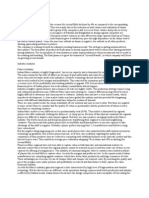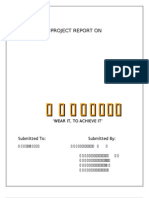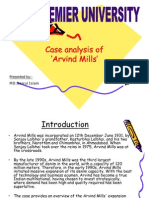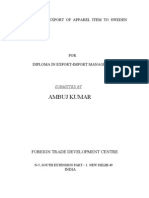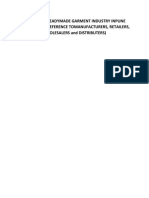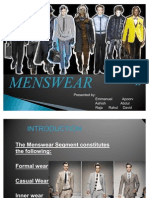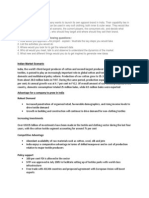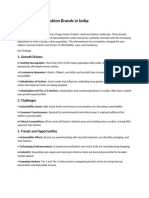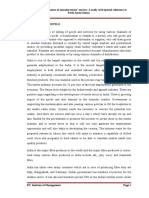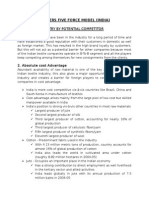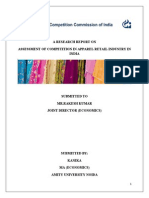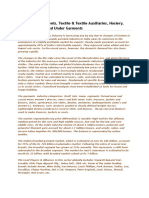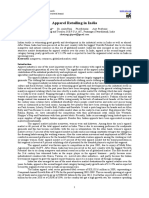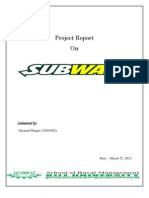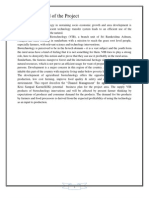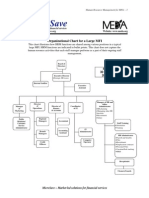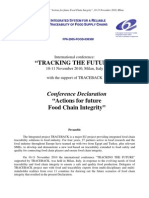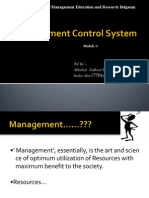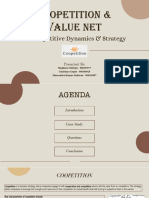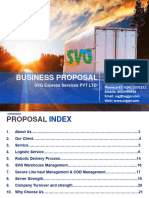Indusrial Analysis Arvind Mills
Indusrial Analysis Arvind Mills
Uploaded by
Akram Ul HoqueCopyright:
Available Formats
Indusrial Analysis Arvind Mills
Indusrial Analysis Arvind Mills
Uploaded by
Akram Ul HoqueCopyright
Available Formats
Share this document
Did you find this document useful?
Is this content inappropriate?
Copyright:
Available Formats
Indusrial Analysis Arvind Mills
Indusrial Analysis Arvind Mills
Uploaded by
Akram Ul HoqueCopyright:
Available Formats
Industrial Analysis of Arvind Mills
Introduction
The national focus paved way for international focus and Arvinds markets shifted from domestic to global, a market that expected and accepted only quality goods. An in-depth analysis of the world textile market proved an eye opener. People the world over were shifting from synthetic to natural fabrics. Cottons were the largest growing segments. But where conventional wisdom pointed to popular priced segments. Arvind has carved out an aggressive strategy to vertically its current operations by setting up world scale garmenting facilities and offering a one-stop shop service, by offering garment packages to its international and domestic customers. With Lee, Wrangler, Arrow and Tommy Hilfiger and its own domestic brands of Flying Machine, Newport, Excalibur and Ruf & Tuf, Arvind set its vision of becoming the largest apparel brands company in India.
Summery
In 1980s Arvinds Mills ltd. The 10 years old Textile mills at Ahmadabad was struggling for market place but within a decade it not only survived but has also become impotence parts of stock exchange. In 1986, Indian textile was dominated by mills with obsolete and marching producing un acceptable quality in international market. The main reason behind for this was state of affair largely the protected domestic market and governments policies discouraging modernization , rigid licensing, high import tariffs and modernization cost was high. The combination of highly negative technology and economic environments and existing of global opportunity in textile industry called bold and innovative approach for survival and growth. Arvind mills examined the textile industry in relation to govt through Portors five forces framework from the analysis it become clear that there was intense rivalry. The government policy in macro economy in the country 1986 gave two clear signals. a) Mounting deficit in budget in pressure on in directed taxes to continue. One could not expect relief on excise taxes and other government controlled input like power, coal, freight etc. b) Rupee would continues to depreciate and government policies always favourable to exporters. The strategic options for Arvind mill to have competitive market with high technology content and capital intensive so that entry barrier for competitors to be high and focus of market shifted to international trade in textile. KIIT SCHOOL OF RURAL MANAGEMENT Page 1
Industrial Analysis of Arvind Mills
The product market segment for the product of Arvind Mills was standard high quality product, high entry barriers, technical competence and specialty products command premium. The strategic implementation faced challenges such as financial, human resources and work culture and government policies (100% export oriented unit policy to remove operational irritants, quota allotment policy for Europe, modernization and revival of closed mills. In new structure of Arvind mills, it focused on just in time delivery, altered its structural relationship based on core processes and concept of value addition, abolishing the hierarchical senior manager. The Arvind mills worked on its human resource by sourcing of proper managerial talent from diverse backgrounds with fresh perspective and preconceived mindset. Finally, the performance of Arvind mills have been have been outstanding with huge export earnings, increase in sales and simultaneously earned huge profit till the 1996. The company realized that major challenges in the next few years would be non-stop renewal of strategy to stay ahead from the competitors, developing better customer orientation and maintaining technological lead for product innovation.
Industry Analysis
Fabrics Industry
Indian fabrics industry is highly fragmented , has excess capacity and is dominated by unorganized sector (97%). The main reasons for this state of affairs are because of past unfavourable and restrictive government policies as the sector was reserved under small-scale industries. Obsolete technology did not allowed for excess to bigger market and as such resulted in low margins and profitability. This restricted the expansion and thus the players got stuck in a vicious cycle of low profitability and resulting inability to upgrade. FDI was not allowed in this sector and as the financial power of Indian players was weak industry consolidation did not happen. Industry is highly capital intensive and economies of scale are highly visible. The production strategy requires long and continuous production runs. Different fabric types and coloring etc. requires different pricing which becomes highly difficult to determine and communicate to customer. Industry does not have a clear market leader, which impedes its development. A clear market leader may have guided the industry and also provided the bargaining power with different stakeholders and would have helped in creation of demand. There are some positives like the cheap availability of raw material and easy access to labor. But these are negated to some extent when we consider that the quality of cotton is questionable and the productivity of labors is lower then those in competing countries. Indian fabric market is very different as it is predominantly rural (65%). This market is dominated by regional players who offer traditional clothing like dhotis etc. at cheap prices. Because of this inherent constraint the regional players are difficult to displace and compete KIIT SCHOOL OF RURAL MANAGEMENT Page 2
Industrial Analysis of Arvind Mills
against. But there are some positive emerging trends in the fabrics industry. The North American and European players are transferring their supplies to Asia and neighbouring countries. This has meant that quality players like Arvind Mills and Raymond have to increase capacity to take advantage of this shift in supplies. Globally a player prefers sourcing form 2-3 manufacturers and follows a long-term commitment. But the negative thing happening now is that some small players have also understood this shift and has invested in technology up gradation. But as these players has not, as of now, any credibility regarding the quality and consistency of their products, they are reduced to competing with established players in the domestic market and this has led to price wars. This resulted in average price realization dropping 5% in denim and 18% in shirting (for Arvind Mills). Players in fabric segment have not been able to capture value in both domestic and international markets. In domestic market this is because the regional players cannot be matched on prices and they make use of their excess capacity by offering at marginal price. The inability of communicating the value to customer has resulted in failure of players like Arvind Mills to capture value. As such the margins and profits are low. In the exports market Indian manufacturers are competing against countries, which have better labor productivity and huge economies of scale. These advantages are overcome by use of cheaper labor and cheaper raw material costs. By matching the quality and prices the margins come under pressure and profitability is reduced and thus failure to fully capture the value.
Garments Industry
As with the fabric's industry garments segment is also characterized by high level of fragmentation and obsolete technology. But the drivers here are different, as the operations strategy requires small batch production and industry is affected by fashion trends. Indian houses do not have the design competencies and is incapable of forecasting the fashion trends. The industry is highly labor intensive and the economies of scale are not there. This segment of industry has also not been able to capture value because there are no established brands. As the industry is plagued by low margins the kind of expenses required to build and sustain a brand is not possible for majority of them. Thus value communication to customer and then capturing the value has been elusive to Indian houses. What has been observed is that the international brands have been able to establish themselves because of huge marketing budgets. They are the one who are capturing the value. One more drawback has been poor infrastructure, which has prevented the expansion into rural India. Weak supply chains have also resulted in high inventory costs and as the garments inherently have low shelf life weak supply chains present some challenge. To recover some costs out of the out of fashion inventory Indian manufacturers resort to discounts and distress selling which dilutes the brand image and destroys the value. In the past because of poor infrastructure, underdeveloped retail channels demand creation and brand building was neglected by majority of players.
Growth Drivers
KIIT SCHOOL OF RURAL MANAGEMENT Page 3
Industrial Analysis of Arvind Mills
We believe that the growth for the industry will come from the demand created by setting up of organized retail/multi retail players. With growing economy, more urbanization, younger and fashion conscious population, increasing disposable incomes and the mall mania, the demand is expected to increase. As customers become more quality conscious and demanding, the small players will need to upgrade the technology and bigger players have to lead the industry by investing in supply chain networks and brand building. Thus we expect industry to consolidate in an interdependent way. Larger players will be focusing on retailing, branding and strengthening the supply chain networks. Small players will upgrade their technology and work as suppliers to larger players fulfilling their fabric and garment needs. But the integrated players will have the competitive advantage. With increasing competition from other countries especially in exports market there will be need for process innovation, which will make Indian products more competitive with an ability to capture value. Once the industry will be able to capture the value it will also build design capabilities and also see product innovation.
The organisation competency over the competitors is as followed :a) The products selected involved high technology contacts and capital intensive so that entry barrier for competitor high. b) The products segments be relatively less dependent on fashion changes. c) The focus should shift to information trade in textile and garments from purely domestic orientation. d) Domestic market is premium price category to prevent imitation.
Major Issues
a) b) c) d) Competitions producing low cost products from China and south east nations. Competitive from domestic market regarding price and quality products. Non stop renewal of strategy to stay ahead of competitions. Develop better custom orientation and maintaining technology lead for product innovation.
KIIT SCHOOL OF RURAL MANAGEMENT
Page 4
Industrial Analysis of Arvind Mills
Arvind mill must develop internal organisation to achieve the competitive advantage over the competitors.
Products New
Existing
Products/ build consolidation of existing brands of Arvind Mills Existing
Products developments new products of Arvind Mills
Markets
Market developments. Market developments for new products New
Diversification Products Diversification
Methods
Internal developments methods:
- It is where strategy is developing by building and developing and Arvind mills own capabilities.
KIIT SCHOOL OF RURAL MANAGEMENT
Page 5
Industrial Analysis of Arvind Mills
The organisation competency over the competitors is as followed:e) The products selected involved high technology contacts and capital intensive so that entry barrier for competitor high. f) The products segments be relatively less dependent on fashion changes. g) The focus should shift to information trade in textile and garments from purely domestic orientation. h) Domestic market is premium price category to prevent imitation.
The challenges faced during implementation of the strategy are:a) Financial: - they borrowed large borrowing to implements the modernization programme. Arvinds proven performance in international trade appealed to investor and large fund mobilised through the capital market. Arvind resave long term financial from ICICI. b) Human resources:- Arvind will realised the import once of human resource to implement its strategy the company inducted professional managers. c) Work Culture:- The shift in focus from domestic to international trade demanded a change is work cultural both in and out side the shop floors new expansion were carried out at new location with fresh personal who could be trained in a conducive work cultural. d) Governments policies:- Arvind mills took a lead in influencing governments to remove herders. These are 100% export oriented unit policy to remove operational irritants. Change in quota allotment policy for Europe to encourage export of high value fabrics. Textile machinery inputs allowed for modernisation. Policy on revival closed will and governments cause forward with a package of incentives for revival of closed mills.
CONCLUSION
A huge window of opportunity has opened up the Indian textile industry for various players need to get act together. Government is playing the role of facilitator by taking various majors. Its now for players to make investments in building the capacities and making them integrated manufacturers. The industry enjoys significant strength and advantages, such as availability of KIIT SCHOOL OF RURAL MANAGEMENT Page 6
Industrial Analysis of Arvind Mills
raw materials, labour, domestic market and supportive government policies. As we analyzed the various data based on questionnaire, a fact has came into light that Arvind Mills is the most known and popular Brand in context of major Textile giant followed by Reliance and Birla Group. Because of applying innovative ideas such as providing various facilities, launching new schemes & offers Arvind Mills garments are more used by people as compared to other one. Except it, people firstly prefer for good quality and comparatively low prices Textile garments then they emphasized on qualities and durability.
KIIT SCHOOL OF RURAL MANAGEMENT
Page 7
You might also like
- Standard Operating Procedure Pharmaceutical Quality Risk Management ToolsDocument15 pagesStandard Operating Procedure Pharmaceutical Quality Risk Management ToolsPharma Life-cycle Consultancy50% (2)
- Strategic Analysis of Raymond App. Ltd.Document8 pagesStrategic Analysis of Raymond App. Ltd.thegr81pary83% (6)
- Strategic Management - Textile Industry (Arvind LTD)Document58 pagesStrategic Management - Textile Industry (Arvind LTD)Diana Aloys82% (17)
- Smoothening The Process of Supply Chain Mandhana Textile MillsDocument50 pagesSmoothening The Process of Supply Chain Mandhana Textile MillsNawaz AhamedNo ratings yet
- Project Report Garment SCMDocument10 pagesProject Report Garment SCMManpreet Singh KhuranaNo ratings yet
- Supply Chain Management Tata MotorDocument25 pagesSupply Chain Management Tata MotorArpit JaiswalNo ratings yet
- This Study Resource Was: Supply Chain ManagementDocument4 pagesThis Study Resource Was: Supply Chain ManagementLê Khắc HùngNo ratings yet
- Arvind MillsDocument8 pagesArvind MillsRonak BhavsarNo ratings yet
- Textile in LucknowDocument91 pagesTextile in Lucknowvps9044No ratings yet
- AATHIKALAMDocument23 pagesAATHIKALAMBoopathi KalaiNo ratings yet
- Readymade Clothes IndustryDocument14 pagesReadymade Clothes IndustrySahil PathanNo ratings yet
- Case Study On The Denim War Will Arvind Come Out A Winner: Submitted byDocument8 pagesCase Study On The Denim War Will Arvind Come Out A Winner: Submitted bySunit MishraNo ratings yet
- Indian Apparel Industry AnalysisDocument27 pagesIndian Apparel Industry AnalysisNIRJHAR MUKHERJEE (IPM 2016-21 Batch)No ratings yet
- Textile Project NIRVANADocument27 pagesTextile Project NIRVANAGosai JaydeepNo ratings yet
- Arvind CaseDocument10 pagesArvind CaseNazrul Islam SujonNo ratings yet
- Pioneer Institute of Professional Studies: SWOT Analysis of Arvind LimitedDocument32 pagesPioneer Institute of Professional Studies: SWOT Analysis of Arvind LimitedAneri PrajapatiNo ratings yet
- Project Report - Garment - SCMDocument10 pagesProject Report - Garment - SCMRajeev SinghNo ratings yet
- Project Report ON "Customer Satisfaction" Apparel Industry"Document53 pagesProject Report ON "Customer Satisfaction" Apparel Industry"Anjali DograNo ratings yet
- Group 9 StrategyDocument11 pagesGroup 9 StrategyPERKYPOKIE94No ratings yet
- A Project Report On Market Strategey of Tommy HilfigerDocument49 pagesA Project Report On Market Strategey of Tommy HilfigerKamal King54% (13)
- Case SubmissionDocument19 pagesCase Submissionazizratan96No ratings yet
- Increasing Textile ExportsDocument10 pagesIncreasing Textile ExportsPratiekNo ratings yet
- South India Spinning Mills PVT LTD Swot Analysis: StrengthsDocument5 pagesSouth India Spinning Mills PVT LTD Swot Analysis: StrengthsananthakumarNo ratings yet
- Project On Export of Apparel Item To SwedenDocument15 pagesProject On Export of Apparel Item To SwedenSudhanshu SriwastavaNo ratings yet
- Nithya Silk Cotton Spinning Mills PVT LTD Swot Analysis: StrengthsDocument5 pagesNithya Silk Cotton Spinning Mills PVT LTD Swot Analysis: StrengthsananthakumarNo ratings yet
- Rural MKTG of FMCGsDocument9 pagesRural MKTG of FMCGsRichBrook7No ratings yet
- GarmentsDocument191 pagesGarmentsBoopathi KalaiNo ratings yet
- RaymondsDocument14 pagesRaymondsChetan G GiteNo ratings yet
- Industry AnalysisDocument2 pagesIndustry AnalysisdhileepandrNo ratings yet
- MENSWEAR Power Point PresentationDocument16 pagesMENSWEAR Power Point PresentationDavid Phillipowsky50% (2)
- A Study of Export of Diamond ProductsDocument39 pagesA Study of Export of Diamond ProductsUniq Manju100% (1)
- Case Study: Indian Market ScenarioDocument4 pagesCase Study: Indian Market ScenarioSandeep ChowdhuryNo ratings yet
- Arvind MillsDocument52 pagesArvind Millszsjkc20No ratings yet
- The Rise of Fast Fashion Brands in IndiaDocument3 pagesThe Rise of Fast Fashion Brands in IndiaUTKARSH GUPTANo ratings yet
- Industry Analysis-SwotDocument5 pagesIndustry Analysis-SwotSamarth DarganNo ratings yet
- OrveeDocument21 pagesOrveeDarshan SachidanandaNo ratings yet
- 2003 Lab AutosavedDocument82 pages2003 Lab AutosavedPIYUSHNo ratings yet
- Porters Five Force ModelDocument7 pagesPorters Five Force Modelniket0No ratings yet
- Zara PrachiDocument16 pagesZara PrachiPrachi_Garg_8226No ratings yet
- MSMEDocument8 pagesMSMEcoolvirgo2000No ratings yet
- Marketing Strategies of Readymade Garments Industry of IndiaDocument14 pagesMarketing Strategies of Readymade Garments Industry of IndiaShabbiQureshiNo ratings yet
- Indian Garment IndustryDocument87 pagesIndian Garment IndustryEmmanuel Tunde Renner50% (2)
- Title:-A Complete Survey and Consumer Satisfaction of AMAR ENTERPRISESDocument7 pagesTitle:-A Complete Survey and Consumer Satisfaction of AMAR ENTERPRISESVishal LodhaNo ratings yet
- Assessment of Competition in Apparel Retail SectorDocument36 pagesAssessment of Competition in Apparel Retail SectorShashank Kumar SinghNo ratings yet
- Readymade GarmentsDocument19 pagesReadymade GarmentsAnonymous 1FrpCENo ratings yet
- Apparel Retailing in IndiaDocument6 pagesApparel Retailing in IndiaAgney KudekarNo ratings yet
- RivalryDocument5 pagesRivalryJanani NagendranNo ratings yet
- Case Studies in Strategy (Catalogue III)Document130 pagesCase Studies in Strategy (Catalogue III)TahseenRanaNo ratings yet
- Strategic Management Report - Alkaram TextilesDocument45 pagesStrategic Management Report - Alkaram TextilesHafsa Azam100% (2)
- 1.1 Introduction To The Study: 1.2 The Present Indian Marketing ScenarioDocument32 pages1.1 Introduction To The Study: 1.2 The Present Indian Marketing ScenarioJohn CenaNo ratings yet
- The Future of Global Trade: Trends and Opportunities in Export-ImportFrom EverandThe Future of Global Trade: Trends and Opportunities in Export-ImportNo ratings yet
- Entrepreneurship: Model Assignment answer with theory and practicalityFrom EverandEntrepreneurship: Model Assignment answer with theory and practicalityNo ratings yet
- Model Answer: E-Commerce store launch by Unilever in Sri LankaFrom EverandModel Answer: E-Commerce store launch by Unilever in Sri LankaNo ratings yet
- Model Answer: Launch of a laundry liquid detergent in Sri LankaFrom EverandModel Answer: Launch of a laundry liquid detergent in Sri LankaNo ratings yet
- Harvard Business Review on Thriving in Emerging MarketsFrom EverandHarvard Business Review on Thriving in Emerging MarketsNo ratings yet
- Enhancing Competitiveness in Small Developing States: Approaches, Tools and PoliciesFrom EverandEnhancing Competitiveness in Small Developing States: Approaches, Tools and PoliciesNo ratings yet
- Zero-Gapped: HOW TO RAISE YOUR BARBERSHOP PERFORMANCE USING TRIED AND TESTED GROWTH HACKING STRATEGIESFrom EverandZero-Gapped: HOW TO RAISE YOUR BARBERSHOP PERFORMANCE USING TRIED AND TESTED GROWTH HACKING STRATEGIESNo ratings yet
- SUBWAY - Marketing PlanDocument22 pagesSUBWAY - Marketing PlanAkram Ul Hoque85% (40)
- Dairy Project (Amul)Document4 pagesDairy Project (Amul)Akram Ul HoqueNo ratings yet
- Amul StrategyDocument18 pagesAmul StrategyAkram Ul Hoque100% (12)
- Akram MTS-1ReportDocument37 pagesAkram MTS-1ReportAkram Ul HoqueNo ratings yet
- Management Traineeship Segment - Ii: Host Organization:-"Gramin Vikas Trust"Document23 pagesManagement Traineeship Segment - Ii: Host Organization:-"Gramin Vikas Trust"Akram Ul HoqueNo ratings yet
- File Handout 2Document1 pageFile Handout 2Akram Ul HoqueNo ratings yet
- Iata Ceiv-Pharma How20to20become20ceiv20pharma20certifiedDocument132 pagesIata Ceiv-Pharma How20to20become20ceiv20pharma20certifiedAdmin OPS APLOG KPNo ratings yet
- Qc/qa PlanDocument25 pagesQc/qa PlanHallow H. SalihNo ratings yet
- Respecting Nature Serving Communities: Samsung Electronics 2004 Green Management ReportDocument40 pagesRespecting Nature Serving Communities: Samsung Electronics 2004 Green Management ReportOmar DahanNo ratings yet
- Q and A FinalDocument33 pagesQ and A FinalNirabh NayanNo ratings yet
- Building Strategic Framework To Analyze Supply Chains: 1.2: Supply Chain Performance: Achieving Strategic Fit and ScopeDocument47 pagesBuilding Strategic Framework To Analyze Supply Chains: 1.2: Supply Chain Performance: Achieving Strategic Fit and ScopePrakash TirumaniNo ratings yet
- Declaration TBKDocument3 pagesDeclaration TBKainia_docsNo ratings yet
- Role of Artificial Intelligence (AI) - IN FOOD INDUSTRYDocument25 pagesRole of Artificial Intelligence (AI) - IN FOOD INDUSTRYAkash DuttaNo ratings yet
- Nestlé CompanyDocument26 pagesNestlé Companymariamnader1264No ratings yet
- Contents of A Procurement PolicyDocument5 pagesContents of A Procurement Policymerlin masterchiefNo ratings yet
- Clauss - (2016) Measuring Business Model Innovation Conceptualization, Scale Development, and Proof of Performance UTILIZADODocument19 pagesClauss - (2016) Measuring Business Model Innovation Conceptualization, Scale Development, and Proof of Performance UTILIZADOHalison SouzaNo ratings yet
- PM Notes 2NDDocument19 pagesPM Notes 2NDsai romeroNo ratings yet
- PTD By: Abhishek Kulkarni) Sachin Shet 0) : KLS's Institute of Management Education and Research BelgaumDocument22 pagesPTD By: Abhishek Kulkarni) Sachin Shet 0) : KLS's Institute of Management Education and Research BelgaumSachin ShetNo ratings yet
- Amul Butter MilkDocument66 pagesAmul Butter MilkManjeet SinghNo ratings yet
- CROPMART - A Transparent Solution For FarmersDocument6 pagesCROPMART - A Transparent Solution For FarmersArman del MundoNo ratings yet
- H&M FMDocument67 pagesH&M FMagga1111100% (1)
- Macgregor 2012Document120 pagesMacgregor 20124mynbwq596No ratings yet
- Coopetition & Value NetDocument12 pagesCoopetition & Value Netmeghanac0106No ratings yet
- Statement of PurposeDocument2 pagesStatement of PurposeAbhishek Ajay DeshpandeNo ratings yet
- FinalReport 090610 2Document12 pagesFinalReport 090610 2mn1938No ratings yet
- Agriculture Syllabus Decode & PYQDocument7 pagesAgriculture Syllabus Decode & PYQPrity KumariNo ratings yet
- Pharma-Report 2023Document8 pagesPharma-Report 2023Shraddha BhosaleNo ratings yet
- Supply Chain Management PII 2024Document79 pagesSupply Chain Management PII 2024Ibnu RahmadaniNo ratings yet
- Circular Economy Adoption Barriers in Built Environm - 2023 - Journal of CleanerDocument20 pagesCircular Economy Adoption Barriers in Built Environm - 2023 - Journal of CleanerClara ParenteNo ratings yet
- Code of Professional Conduct of Interior DesignsDocument14 pagesCode of Professional Conduct of Interior Designsrevathi hariharan100% (1)
- How Close Is Too CloseDocument2 pagesHow Close Is Too CloseBen AcuttNo ratings yet
- Profile Logistic ManagementDocument25 pagesProfile Logistic ManagementFerdy (Ferdy)No ratings yet
- Harsh ReportDocument63 pagesHarsh ReportHarsh PatelNo ratings yet








